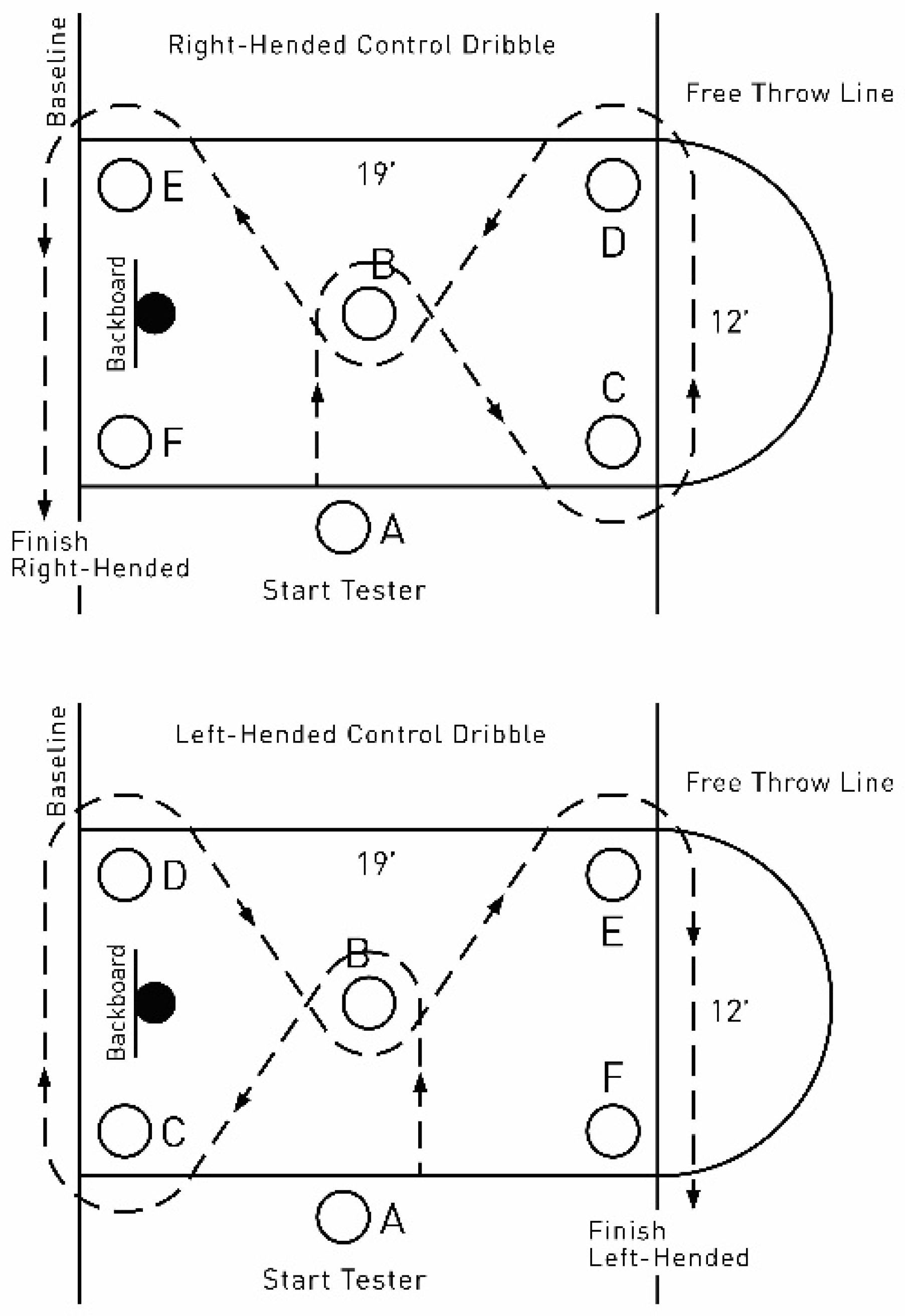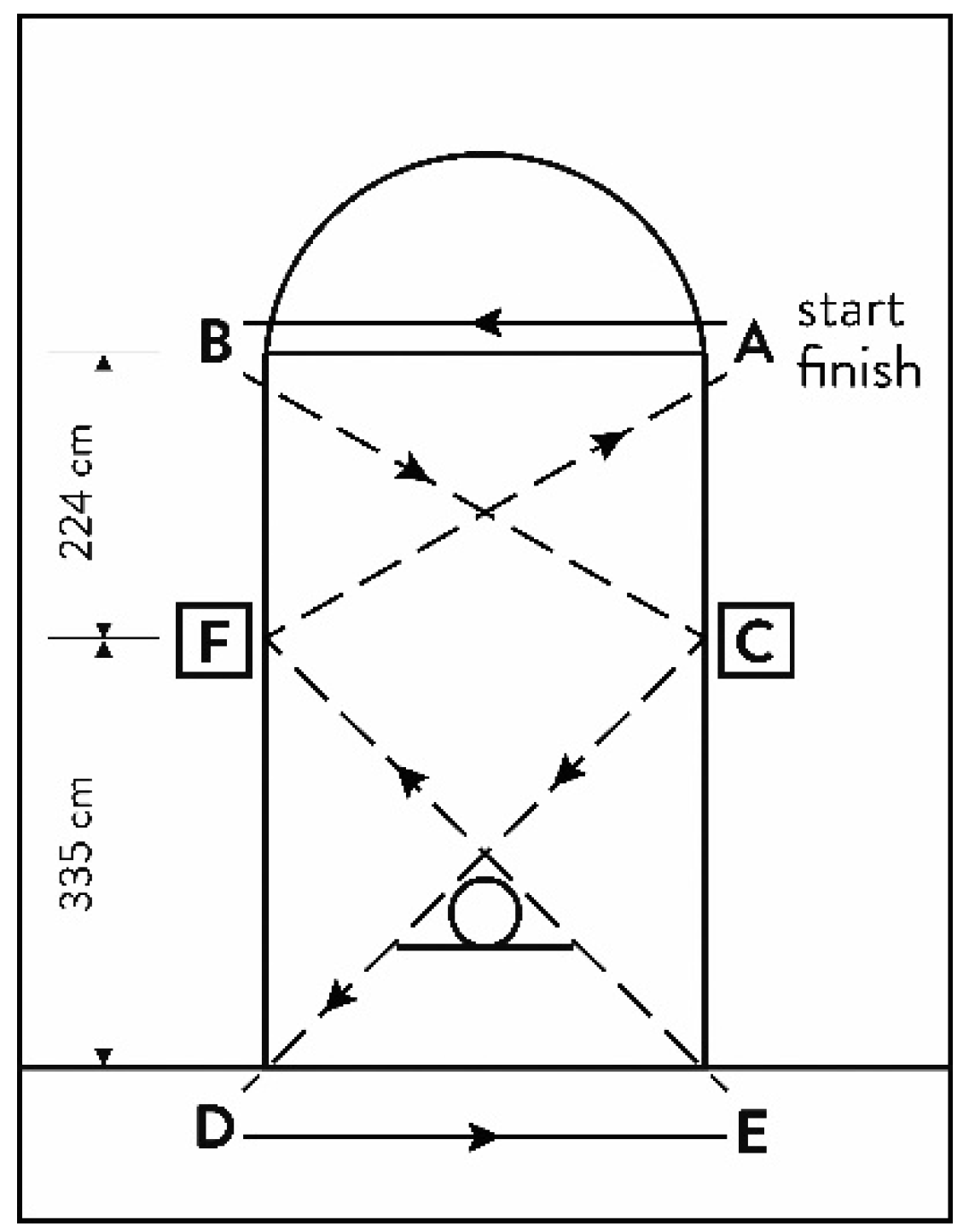Specific Physical Ability Prediction in Youth Basketball Players According to Playing Position
Abstract
:1. Introduction
2. Materials and Methods
2.1. Participants
2.2. Measurement Procedure
2.2.1. Sprint Tests
2.2.2. Change of Direction Speed with and without the Ball
2.2.3. Vertical Jumps
2.3. Statistical Procedures
3. Results
4. Discussion
Limitations
5. Conclusions
Practical Applications
Author Contributions
Funding
Institutional Review Board Statement
Informed Consent Statement
Data Availability Statement
Acknowledgments
Conflicts of Interest
References
- Mancha-Triguero, D.; García-Rubio, J.; Calleja-González, J.; Ibáñez, S.J. Physical fitness in basketball players: A systematic review. J. Sports Med. Phys. Fit. 2019, 59, 1513–1525. [Google Scholar] [CrossRef]
- Wen, N.; Dalbo, V.J.; Burgos, B.; Pyne, D.B.; Scanlan, A.T. Power testing in basketball: Current practice and future recommendations. J. Strength Cond. Res. 2018, 32, 2686–2700. [Google Scholar] [CrossRef]
- Zarić, I.; Dopsaj, M.; Marković, M. Match performance in young female basketball players: Relationship with laboratory and field tests. Int. J. Perform. Anal. Sport 2018, 18, 90–103. [Google Scholar] [CrossRef]
- Stojanović, E.; Stojiljković, N.; Scanlan, A.T.; Dalbo, V.J.; Berkelmans, D.M.; Milanović, Z. The activity demands and physiological responses encountered during basketball match-play: A systematic review. Sports Med. 2018, 48, 111–135. [Google Scholar] [CrossRef] [PubMed]
- Ferioli, D.; Rampinini, E.; Bosio, A.; La Torre, A.; Azzolini, M.; Coutts, A.J. The physical profile of adult male basketball players: Differences between competitive levels and playing positions. J. Sports Sci. 2018, 36, 2567–2574. [Google Scholar] [CrossRef] [PubMed]
- Belyakova, A.; Gorskaya, I. Psychomotor abilities as a factor of future success in athletes. Hum. Sports Med. 2021, 21, 102–107. [Google Scholar] [CrossRef]
- Zatsiorsky, V.M.; Kraemer, W.J. Science and Practice of Strength Training, 2nd ed.; Human Kinetics: Champaign, IL, USA, 2006. [Google Scholar]
- Ivanović, J.; Dopsaj, M.; Jakovljević, S.; Karalejić, M. Relationship between isometric neuromuscular function of the leg extensors with performance tests in basketball. Russ. Open Med. J. 2019, 8, 1–8. [Google Scholar] [CrossRef]
- Drinkwater, E.J.; Pyne, D.B.; McKenna, M.J. Design and interpretation of anthropometric and fitness testing of basketball players. Sports Med. 2008, 38, 565–578. [Google Scholar] [CrossRef] [PubMed]
- Toselli, S.; Campa, F.; Maietta Latessa, P.; Greco, G.; Loi, A.; Grigoletto, A.; Zaccagni, L. Differences in Maturity and Anthropometric and Morphological Characteristics among Young Male Basketball and Soccer Players and Non-Players. Int. J. Environ. Res. Public Health 2021, 18, 3902. [Google Scholar] [CrossRef]
- Towlson, C.; Cobley, S.; Parkin, G.; Lovell, R. When does the influence of maturation on anthropometric and physical fitness characteristics increase and subside? Scand. J. Med. Sci. Sports 2018, 28, 1946–1955. [Google Scholar] [CrossRef] [PubMed]
- Arede, J.; Fernandes, J.; Moran, J.; Norris, J.; Leite, N. Maturity timing and performance in a youth national basketball team: Do early-maturing players dominate? Int. J. Sports Sci. Coach 2021, 16, 722–730. [Google Scholar] [CrossRef]
- Delextrat, A.; Cohen, D. Strength, power, speed, and agility of women basketball players according to playing position. J. Strength Cond. Res. 2009, 23, 1974–1981. [Google Scholar] [CrossRef]
- Köklü, Y.; Alemdaroğlu, U.; Koçak, F.; Erol, A.; Findikoğlu, G. Comparison of Chosen Physical Fitness Characteristics of Turkish Professional Basketball Players by Division and Playing Position. J. Hum. Kinet. 2011, 30, 99–106. [Google Scholar] [CrossRef]
- Boone, J.; Bourgois, J. Morphological and Physiological Profile of Elite Basketball Players in Belgium. Int. J. Sports Physiol. Peform. 2013, 8, 630–638. [Google Scholar] [CrossRef] [PubMed] [Green Version]
- Brini, S.; Ben Abderrahman, A.; Boullosa, D.; Hackney, A.C.; Zagatto, A.M.; Castagna, C.; Bouassida, A.; Granacher, U.; Zouhal, H. Effects of a 12-Week Change-of-Direction Sprints Training Program on Selected Physical and Physiological Parameters in Professional Basketball Male Players. Int. J. Environ. Res. Public Health 2020, 17, 8214. [Google Scholar] [CrossRef]
- Markovic, G.; Dizdar, D.; Jukic, I.; Cardinale, M. Reliability and factorial validity of squat and countermovement jump tests. J. Strength Cond. Res. 2004, 18, 551–555. [Google Scholar] [CrossRef]
- Maggioni, M.A.; Bonato, M.; Stahn, A.; La Torre, A.; Agnello, L.; Vernillo, G.; Castagna, C.; Merati, G. Effects of Ball Drills and Repeated-Sprint-Ability Training in Basketball Players. Int. J. Sports Physiol. Perform. 2019, 14, 757–764. [Google Scholar] [CrossRef] [Green Version]
- Rojas-Valverde, D.; Pino-Ortega, J.; Gómez-Carmona, C.D.; Rico-González, M. A Systematic Review of Methods and Criteria Standard Proposal for the Use of Principal Component Analysis in Team’s Sports Science. Int. J. Environ. Res. Public Health 2020, 17, 8712. [Google Scholar] [CrossRef]
- Majstorović, N.; Dopsaj, M.; Grbić, V.; Savić, Z.; Vićentijević, A.; Aničić, Z.; Zadražnik, M.; Toskić, L.; Nešić, G. Isometric Strength in Volleyball Players of Different Age: A Multidimensional Model. Appl. Sci. 2020, 10, 4107. [Google Scholar] [CrossRef]
- Abdelkrim, N.B.; Chaouachi, A.; Chamari, K.; Chtara, M.; Castagna, C. Positional role and competitive-level differences in elite-level men’s basketball players. J. Strength Cond. Res. 2010, 24, 1346–1355. [Google Scholar] [CrossRef] [PubMed]
- Markovic, G.; Mikulic, P. Neuro-Musculoskeletal and Performance Adaptations to Lower Extremity Plyometric Training. Sports Med. 2010, 4, 859–895. [Google Scholar] [CrossRef]
- Ben-Zaken, S.; Eliakim, A.; Nemet, D.; Meckel, Y. Genetic Variability Among Power Athletes: The Stronger vs. the Faster. J. Strength Cond. Res. 2019, 33, 1505–1511. [Google Scholar] [CrossRef] [PubMed]
- Young, W.B. Transfer of strength and power training to sports performance. Int. J. Sports Physiol. Perform. 2006, 1, 74–83. [Google Scholar] [CrossRef] [PubMed] [Green Version]
- Zouita, S.; Zouita, A.B.M.; Kebsi, W.; Dupont, G.; Ben Abderrahman, A.; Ben Salah, F.Z.; Zouhal, H. Strength training reduces injury rate in elite young soccer players during one season. J. Strength Cond. Res. 2016, 30, 1295–1307. [Google Scholar] [CrossRef]
- Case, M.J.; Knudson, D.V.; Downey, D.L. Barbell squat relative strength as an identifier for lower extremity injury in collegiate athletes. J. Strength Cond. Res. 2020, 34, 1249–1253. [Google Scholar] [CrossRef] [PubMed]
- Sporiš, G.; Šango, J.; Vučetić, V.; Mašina, T. The latent structure of standard game efficiency indicators in basketball. Int. J. Perform. Anal. Sport 2006, 6, 120–129. [Google Scholar] [CrossRef]
- Gómez-Carmona, C.D.; Mancha-Triguero, D.; Pino-Ortega, J.; Ibáñez, S.J. Exploring Physical Fitness Profile of Male and Female Semiprofessional Basketball Players through Principal Component Analysis—A Case Study. J. Funct. Morphol. Kinesiol. 2021, 6, 67. [Google Scholar] [CrossRef] [PubMed]



| Guard | Forward | Center | Test–Retest Reliability | ||
|---|---|---|---|---|---|
| Mean ± SD | Mean ± SD | Mean ± SD | Average Int-Item Correlation | Bartlett’s Test of Sphericity | |
| Q5m (s) | 1.817 ± 0.413 | 1.606 ± 0.522 | 1.820 ± 0.547 | 0.977 | F = 42.775 * |
| Q5mD (s) | 1.883 ± 0.426 | 1.721 ± 0.647 | 1.905 ± 0.587 | 0.732 | F = 3.735 * |
| A15m (s) | 1.185 ± 0.378 | 1.445 ± 0.520 | 1.372 ± 0.489 | 0.814 | F = 5.384 * |
| A15mD (s) | 1.212 ± 0.396 | 1.494 ± 0.573 | 1.437 ± 0.501 | 0.689 | F = 3.218 * |
| S20m (s) | 3.002 ± 0.117 | 3.052 ± 0.180 | 3.194 ± 0.128 | 0.967 | F = 30.166 * |
| S20mD (s) | 3.096 ± 0.154 | 3.215 ± 0.292 | 3.344 ± 0.162 | 0.866 | F = 7.488 * |
| TTEST (s) | 10.321 ± 0.402 | 10.481 ± 0.711 | 11.282 ± 0.695 | 0.970 | F = 33.330 * |
| DM (s) | 18.038 ± 0.860 | 18.351 ± 1.252 | 19.601 ± 1.377 | 0.960 | F = 25.079 * |
| Slalom (s) | 4.117 ± 0.178 | 4.199 ± 0.253 | 4.443 ± 0.213 | 0.956 | F = 22.797 * |
| SlalomD (s) | 4.214 ± 0.180 | 4.349 ± 0.272 | 4.629 ± 0.292 | 0.959 | F = 24.441 * |
| COD (s) | 11.922 ± 0.463 | 12.114 ± 0.787 | 12.582 ± 0.905 | 0.927 | F = 13.773 * |
| CODD (s) | 12.482 ± 0.404 | 12.713 ± 0.825 | 13.036 ± 0.653 | 0.953 | F = 21.394 * |
| COND(s) | 12.852 ± 0.840 | 13.144 ± 1.144 | 13.643 ± 1.180 | / | / |
| CMJ (cm) | 41.16 ± 6.20 | 39.15 ± 5.93 | 35.79 ± 4.33 | 0.992 | F = 119.140 * |
| CMJAS (cm) | 48.77 ± 6.30 | 47.62 ± 6.76 | 43.67 ± 5.60 | 0.984 | F = 63.837 * |
| SJ (cm) | 34.59 ± 5.77 | 33.49 ± 5.70 | 30.28 ± 4.69 | 0.974 | F = 38.620 * |
| SGJ (cm) | 49.34 ± 6.61 | 48.05 ± 7.66 | 43.02 ± 3.72 | 0.929 | F = 14.044 * |
| Factor | Extraction Sums of Squared Loadings | ||||||||
|---|---|---|---|---|---|---|---|---|---|
| Total | % of Variance | Cumulative % | |||||||
| Guard | Forward | Center | Guard | Forward | Center | Guard | Forward | Center | |
| 1 | 6.719 | 9.997 | 11.333 | 39.523 | 58.804 | 66.664 | 39.523 | 58.804 | 66.664 |
| 2 | 3.644 | 3.899 | 2.465 | 21.435 | 22.936 | 14.499 | 60.958 | 81.739 | 81.162 |
| 3 | 2.705 | 1.085 | 1.100 | 15.909 | 6.384 | 6.471 | 76.867 | 88.123 | 87.633 |
| Factor | Guard | Forward | Center | |||
|---|---|---|---|---|---|---|
| Variables | Value | Variables | Value | Variables | Value | |
| 1st factor | TTEST | 0.804 | CMJAS | −0.966 | COND | 0.962 |
| DM | 0.783 | CMJ | −0.957 | CODD | 0.940 | |
| S20mD | 0.762 | S20 | 0.934 | COD | 0.916 | |
| Slalom | 0.759 | TTEST | 0.918 | Slalom | 0.891 | |
| SlalomD | 0.754 | SJ | −0.912 | TTEST | 0.887 | |
| COD | 0.749 | SGJ | −0.897 | SlalomD | 0.848 | |
| CODD | 0.749 | Slalom | 0.878 | DM | 0.834 | |
| COND | 0.720 | SlalomD | 0.834 | S20m | 0.821 | |
| S20m | 0.624 | CODD | 0.823 | S20mD | 0.818 | |
| 2nd factor | A15m | −0.984 | A15m | −0.983 | A15m | 0.993 |
| Q5mD | 0.984 | A15mD | −0.977 | A15mD | 0.990 | |
| Q5m | 0.980 | Q5m | 0.967 | Q5m | −0.980 | |
| A15mD | −0.973 | Q5mD | 0.959 | Q5mD | −0.969 | |
| 3rd factor | CMJ | 0.974 | COND | 0.869 | SGJ | 0.949 |
| CMJAS | 0.944 | DM | 0.846 | CMJAS | 0.943 | |
| SJ | 0.886 | COD | 0.828 | CMJ | 0.871 | |
| SGJ | 0.813 | S20mD | 0.827 | SJ | 0.860 | |
Publisher’s Note: MDPI stays neutral with regard to jurisdictional claims in published maps and institutional affiliations. |
© 2022 by the authors. Licensee MDPI, Basel, Switzerland. This article is an open access article distributed under the terms and conditions of the Creative Commons Attribution (CC BY) license (https://creativecommons.org/licenses/by/4.0/).
Share and Cite
Ivanović, J.; Kukić, F.; Greco, G.; Koropanovski, N.; Jakovljević, S.; Dopsaj, M. Specific Physical Ability Prediction in Youth Basketball Players According to Playing Position. Int. J. Environ. Res. Public Health 2022, 19, 977. https://doi.org/10.3390/ijerph19020977
Ivanović J, Kukić F, Greco G, Koropanovski N, Jakovljević S, Dopsaj M. Specific Physical Ability Prediction in Youth Basketball Players According to Playing Position. International Journal of Environmental Research and Public Health. 2022; 19(2):977. https://doi.org/10.3390/ijerph19020977
Chicago/Turabian StyleIvanović, Jelena, Filip Kukić, Gianpiero Greco, Nenad Koropanovski, Saša Jakovljević, and Milivoj Dopsaj. 2022. "Specific Physical Ability Prediction in Youth Basketball Players According to Playing Position" International Journal of Environmental Research and Public Health 19, no. 2: 977. https://doi.org/10.3390/ijerph19020977
APA StyleIvanović, J., Kukić, F., Greco, G., Koropanovski, N., Jakovljević, S., & Dopsaj, M. (2022). Specific Physical Ability Prediction in Youth Basketball Players According to Playing Position. International Journal of Environmental Research and Public Health, 19(2), 977. https://doi.org/10.3390/ijerph19020977










